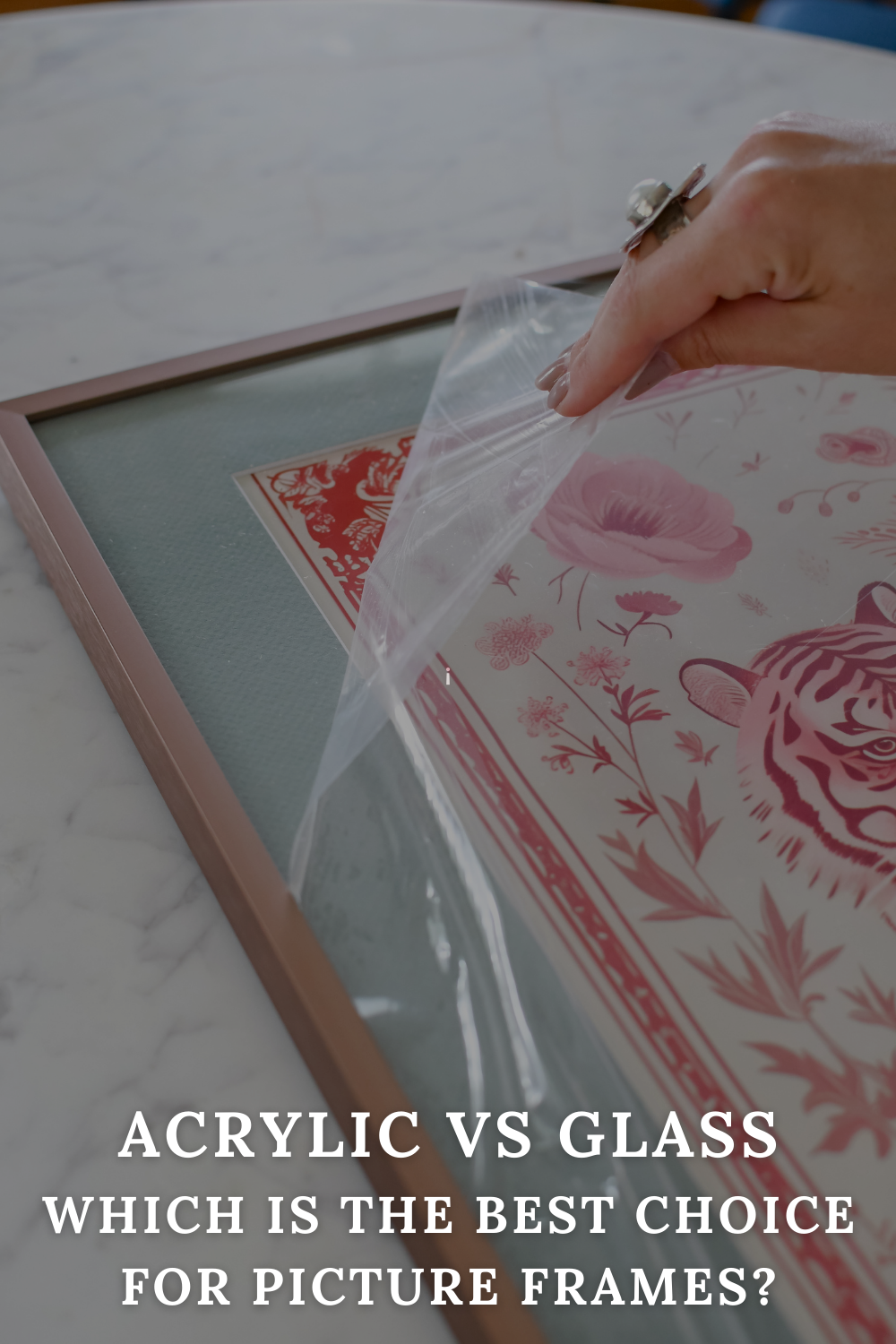What is the best material to protect, preserve, and showcase your framed art & photos?

You’ve selected the custom frame you want to display your precious artwork or photo, but then you realize something: There are choices between acrylic or glass for covers, and you want to know which type and variety would suit your needs and price range best.
In the guide below, we’ll walk you through a few basic steps you should know about acrylic or glass covers for picture frames.
The cover (or “glazing material”) is a key part of any frame– custom or otherwise– as this is what allows you to see your special art or photo inside. Just as the backing material of your frame needs to preserve the integrity of your art, the cover should not only allow you to clearly view it, but also protect it from outside forces.
Picture Frame Cover Glazing Materials

There are generally two types of material that make up covers for frames: acrylic or glass.
Glass Frame Covers
You’ll more likely find glass (often referred to as “museum glass” or “conservation glass”) at a local frame shop because it is often considered a more “professional” material.
Glass, while fragile, is still generally less susceptible to scratching (making it easier to clean), but it can also be significantly heavier than acrylic.
For larger picture frames— over 16” X 20”— the weight difference between a glass and acrylic cover can be significant, which is why glass is more frequently used for smaller picture frames. (Think of how heavy other common glass objects can be. For example, a glass fish tank will outweigh its acrylic counterpart of the same volume by 4-10 times.)
Acrylic Frame Covers
Online framers most often use acrylic to reduce the possibility of damage during delivery. Using glass could create issues with having to replace excessive amounts of damaged products, as well as the possible liability issue; glass is sharp and dangerous when shattered.
When it comes to price, acrylic can actually be more expensive than glass but offers many advantages. Acrylic is often clearer than glass (which can have a green tint), and due to its lighter weight, acrylic is also more cost-effective to ship.
Acrylic is a thermoplastic developed in 1933, and its main disadvantage to real glass is its higher likelihood of being scratched. Because of this, acrylic should be shipped with protective covers on each side, ensuring the potential scratches would only happen to the protective sheets, and not the cover itself.
You should only clean acrylic covers with a microfiber cloth (using mild soap in extreme cases). Anything beyond this could risk damaging the cover. Acrylic is also flexible, making it less likely to break than glass. Keep this in mind when planning for picture frame maintenance!

Picture Frame Cover Finishes (Clear or Non-Glare)
When choosing a cover for your frame, what finish you prefer is also a consideration. There are two main options that would be ideal for different types of art.
Clear Finish
First, there is the clear finish, which is the most conventional and would be ideal for most art. Whether acrylic or glass, it would be like looking through a window.
If your art is colorful, clear would be the best option, as it would not soften any of the colors in your photo or artwork.
However, the clear finish is reflective, and it could cause glare if placed near a window, where the sun would shine through.
Non-Glare Finish
If glare from sunshine is an issue, we would recommend using non-glare.
This will soften the color of your artwork, so we recommend using it if your overall piece doesn’t have bright colors, or is entirely in black and white.
Non-glare acrylic will also diffuse sunlight that hits it, which would make your artwork more viewable if it’s near a window.

UV Protection for Framed Art
Of all the outside forces that could damage your art, light is one of them. Ultraviolet (UV) Radiation, which is emitted by the sun and the average light bulb, can damage your print over time.
Standard acrylic or glass blocks ultraviolet rays of a certain length but leaves the artwork exposed to radiation beyond that.
Because of this, certain acrylics and glass are enhanced with UV-protective coatings. These coatings protect your frame from UV rays beyond the standard length.
We recommend asking your framer what sort of acrylic or glass options they offer, and the protective capabilities of each kind.
The more protective varieties would likely be more expensive, so if cost is an issue, think about how close you plan to hang your art to a window opening, and how well-lit the room might be.
Both would be good considerations for the degree of UV protection that you would need.
Even if you’re not framing a priceless work of rare art, overexposure to light can damage any piece of art or photo, so you’ll want to minimize this possibility as much as possible.
Most casual framers do not need to be overly concerned with maximum UV protection, but it’s nice to have for peace of mind.

Glass vs. Acrylic
Glass Display | – Light is very reflective and can have a green tint. | Acrylic Display | – Has non-glare option. |
| Glass Mobility | – Heavy frame that is difficult to move. – Needs additional wall support for large frames. | Acrylic Mobility | – Lightweight frame that can be easily relocated. |
| Glass Liability | – Heavier frame could result in more serious damages. – Person could get cut from shattered glass. – Artwork could be damaged by shattered glass. | Acrylic Liability | – Lightweight frame will prevent serious damages if it falls. – Acrylic can break, but it will not shatter. |
| Glass Art Preservation | – Protects from dust; picks up little electromagnetic charge. – Condensation can form on surface. – Can block a certain percentage of UV light depending on type. | Acrylic Art Preservation | – Protects from dust, although carries a higher electromagnetic charge. – Little chance of condensation forming. – Can block a certain percentage of UV light depending on type. |
| Glass Cost | – Generally less expensive material-wise, but more expensive to ship | Acrylic Cost | – Generally more expensive cost-wise, but less expensive to ship |

Here at Frame It Easy, we exclusively use acrylic, and offer it in three types: clear, non-glare, and conservation clear. All framing-grade acrylic options filter varying degrees of UV light and are UV stable.
Our Clear Acrylic offers the beautiful clarity of the finest picture frame glazing at half the weight of glass and many times the impact resistance. 1.5mm thick and protects your art from 66% of UV light. It is the preferred material for larger framed art and provides the safety warranted in high traffic areas. It is the ideal glazing material for museums, galleries, and homes. Perfect for the casual framer decorating their home or business.
Our Non-Glare Acrylic has all of the clarity, impact resistance, and ultraviolet protection of our Clear Acrylic, but with a very fine matted coating that elegantly diffuses light and reduces reflections. 1.5mm thick and protects your art from 66% of UV light. (Not recommended for art that includes matting as it will cause a less crisp display.) Perfect for reducing glare, but not recommended for art that includes matting as it will cause a less crisp display.
Our Conservation Clear Acrylic provides superior clarity with 99% UV protection, preserving your art without color distortion. Extra durable and rigid at 3mm thick. Perfect for artists, museums, galleries, larger works, and anything that you want to preserve long-term.
Final Thoughts
Which material is right for you and your art comes down to personal preference, but here are the main things to consider when deciding between acrylic or glass:
- Acrylic is lighter than glass and, thus more affordable to ship. It is also more durable, which makes it ideal for frames ordered online.
- Glass is heavier and more fragile, but some people prefer it for the aesthetic, or because it’s less susceptible to scratching. It can still shatter easily, though.
- UV light can harm your frame, so we definitely recommend getting a cover with some degree of UV protection.
- A clear finish is best if you don’t mind glare, intend to place your frame in a place where glare wouldn’t be an issue, or have vibrant colors in your art.
- Non-Glare would soften the colors in your artwork, so if you have a black-and-white print and intend to hang it in a place where light might hit it, it might be best.
Ready to order your own frame? Check out our full line of frame styles and get designing!

